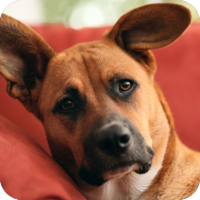
In this section, learn how to help your pet feel at home!
Whether your pet lives indoors or outdoors, creating a clean and healthy environment is important to your pet’s health and well-being. Learn how to help your pet feel at home! Welcoming your pet, training your pet, and taking care of your pet’s health and vaccinations will help you and your pet live a healthy and happy life together. Be sure to consult your veterinarian for any questions about your pet’s needs.
Prepare your house for your pet’s arrival. A special place should be designated for it to eat, sleep, and eliminate. Obtain any necessary accessories (eg, collar, leash, ID tag, crate, cage, aquarium and dishes) before you bring your pet home. For most pets, you will need to pet-proof your home just as you would child-proof your home to avoid accidents. Harmful cleansers, plants, electrical cords, and breakable objects should be kept out of reach. Open windows should be screened.
Roaming pets are prime candidates for fights with other animals, traffic accidents, and communicable diseases from other animals. Their life span can be expected to be considerably shorter as a result. read more
View Article
Pets, like people, can be protected from some diseases by vaccination. Although this resource provides basic information about vaccinations for your dog or cat, your veterinarian is your best source for advice regarding your pet’s vaccination needs.
What are vaccines?
Vaccines are health products that trigger protective immune responses in pets and prepare them to fight future infections from disease-causing agents. Vaccines can lessen the severity of future diseases and certain vaccines can prevent infection altogether. Today, a variety of vaccines are available for use by veterinarians. read more
View Article
Obedience Training
A MUST for every good family dog, regardless of size or breed! Puppies may start classes when they are as young as 8 weeks old. Obedience training is fun. It helps prevent negative encounters between family members and the dog. It reinforces the bond between the handler(s) and pet. Consult veterinarians, breeders, local training clubs, YMCAs, recreation centers, and newspaper columns on dogs or pets for details about classes, costs, and requirements.
Housebreaking
Begin as soon as the puppy arrives in your home. Young puppies should be taken out immediately upon waking and just before retiring, as well as multiple times during the day. Most puppies cannot “hold it” for long periods so it will be necessary to take the puppy out almost every hour at first (especially after periods of play, naps, and mealtimes), and then gradually increase the amount of time between visits to the “bathroom.” Take the puppy to the same area each time and praise it immediately and enthusiastically when it eliminates. Do not play with, or talk to, the puppy until after it has eliminated. Remember, if the puppy doesn’t eliminate outside, its urine and feces are being saved for deposit inside your house! read more
View Article

